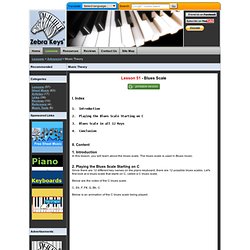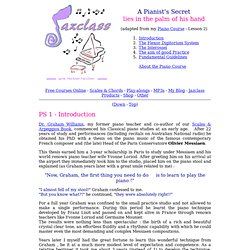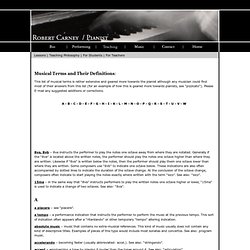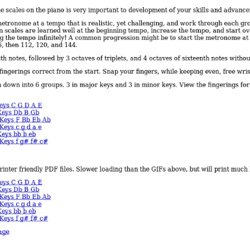

Blues Scale. I.

Index 1. Introduction 2. Playing the Blues Scale Starting on C 3. Blues Scale in all 12 Keys 4. II. 1. In this lesson, you will learn about the blues scale. 2. Since there are 12 different key names on the piano keyboard, there are 12 possible blues scales. Below are the notes of the C blues scale. C, Eb, F, F#, G, Bb, C Below is an animation of the C blues scale being played. 3.
Below is a list of the blues scale starting on all 12 keys. Bb, Db, Eb, E, F, Ab, Bb Db, Fb, Gb, G, Ab, Cb, Db Eb, Gb, Ab, A, Bb, Db, Eb. Free Piano Sheet Music Download. The Real Book of Jazz Volume II [Sheet Music - Score - Piano] Fundamentals of Piano Practice: Chapter 1: Piano Technique. Piano Technique : Anatomy of the Hand and its relevance to a fluent finger technique.
Free Courses Online - Scales & Chords - Play-alongs - MP3s - My Blog - Jazclass Products - Shop - Other (Down - Top) PS 1 - Introduction Dr.

Graham Williams, my former piano teacher and co-author of our Scales & Arpeggios Book, commenced his Classical piano studies at an early age. After 22 years of study and performances (including recitals on Australian National radio) he obtained his PhD with a thesis on the piano music of the famous contemporary French composer and (the late) Head of the Paris Conservatoire Olivier Messiaen. This thesis earned him a 3-year scholarship in Paris to study under Messiaen and his world renown piano teacher wife Yvonne Loriod.
"Now, Graham, the first thing you need to do is to learn to play the piano ! " "I almost fell of my stool! " For a full year Graham was confined to the small practice studio and not allowed to make a single performance. (Down - Up - Top) PS 2 - The Flexor Digitorium System Finger movements are largely controlled by two muscle systems. Musical Dictionary! Piano Terms and Definitions. Musical Aids for Piano and Music Students! This list of musical terms is rather extensive and geared more towards the pianist although any musician could find most of their answers from this list (for an example of how this is geared more towards pianists, see "pizzicato").

Please E-mail any suggested additions or corrections. <A HREF=" Widgets</A> 8va, 8vb – 8va instructs the performer to play the notes one octave away from where they are notated. Generally if the “8va” is located above the written notes, the performer should play the notes one octave higher than where they are written. Likewise if “8va” is written below the notes, then the performer should play them one octave lower than where they are written. 15ma – in the same way that “8va” instructs performers to play the written notes one octave higher or lower, “15ma” is used to indicate a change of two octaves.
A piacere – see “piacere”. Glossary of Musical Terms. Hanon-online.com - Piano practice with 'The Virtuoso Pianist in 60 Exercises' by C. L. Hanon. Best Piano Exercises. Home » Piano Technique » Piano Exercises There are lots of different exercises in this page (Inspired by the Hanon Exercises.

Learning to play the piano smoothly is easy with these exercises. Those of you who have followed the complete beginning piano lessons course of our piano action guide know that I recommend playing an E.D exercise (every day) for the first five minutes of each practice. These piano exercises won't cost too mcuh of your time. They will help you to improve a few elements of your piano playing such as: Improving the independence of each of your fingers. Acquiring different dexterities that will allow you to switch fingers smoothy. Getting to know the geography of the piano (by playing on different scales and places on the piano). Learning to sit well while you play the piano and play smoothly without causing stress and pain in your muscles. Fine-tuning your rhythmic sense and your ability to express different types of hand and body movements on the piano. Pianolicious.
Proper fingering for piano scales. Proper fingering of the scales on the piano is very important to development of your skills and advancement as a pianist.

Begin by setting the metronome at a tempo that is realistic, yet challenging, and work through each group of keys, doing one group per week. When scales are learned well at the beginning tempo, increase the tempo, and start over with Group I again. Keep increasing the tempo infinitely! A common progression might be to start the metronome at a quarter note equals 80, and increase to 96, then 112, 120, and 144.
Play 2 octaves of eighth notes, followed by 3 octaves of triplets, and 4 octaves of sixteenth notes without missing a beat. Remember to get the fingerings correct from the start. The scales are broken down into 6 groups. 3 in major keys and 3 in minor keys. The below list is for printer friendly PDF files. Music Page - Home Page. Staff and Bar Lines - Building a Musical Staff. Piano Finger Techniques - Learn Finger Techniques for Piano.